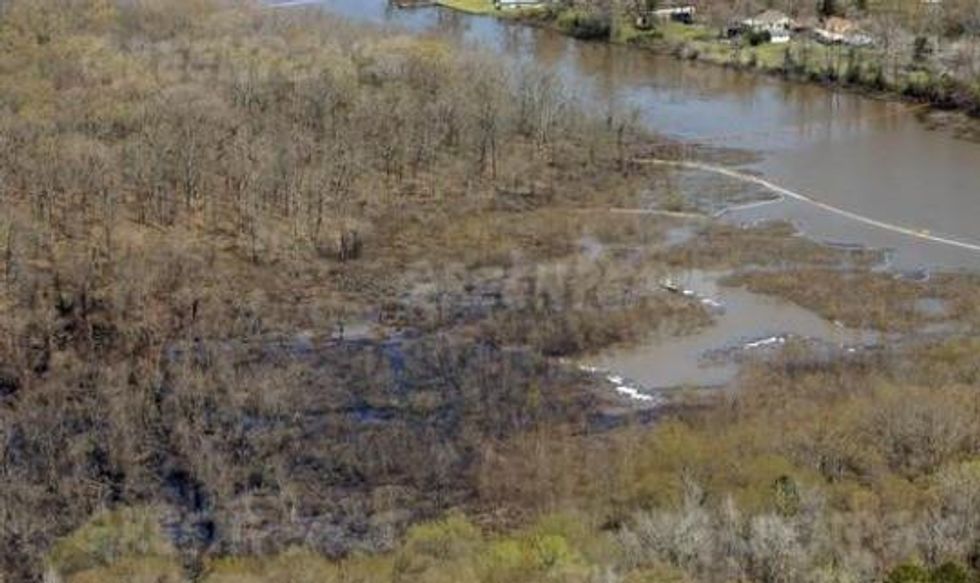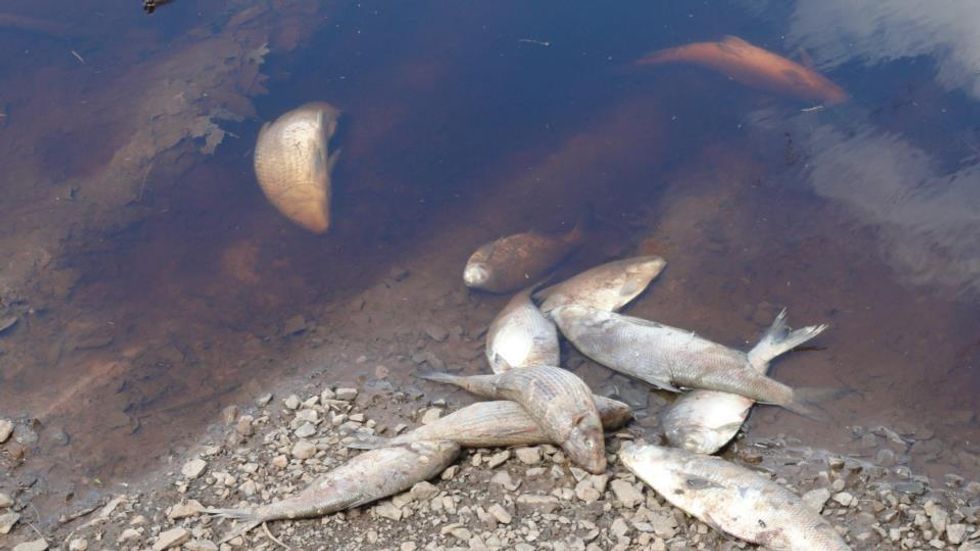May 22, 2013

Following the rupture of the Pegasus pipeline in the town of Mayflower on March 29, area residents were increasingly concerned that Lake Conway had been contaminated. Despite overwhelming evidence that tar sands oil was in the lake, ExxonMobil publicly said this was not the case.
A blog post by Greenpeace's Jesse Coleman explains:
A new batch of documents received by Greenpeace in response to a Freedom of Information Act (FOIA) request to the Arkansas Department of Environmental Quality (DEQ) has revealed that Exxon downplayed the extent of the contamination caused by the ruptured pipeline. Records of emails between Arkansas' DEQ and Exxon depict attempts by Exxon to pass off press releases with factually false information. In a draft press release dated April 8, Exxon claims "Tests on water samples show Lake Conway and the cove are oil-free." However, internal emails from April 6 show Exxon knew of significant contamination across Lake Conway and the cove resulting from the oil spill.
When the chief of Arkansas Hazardous Waste division called Exxon out on this falsehood, Exxon amended the press release. However, they did not amend it to say that oil was in Lake Conway and contaminant levels in the lake were rising to dangerous levels, as they knew to be the case. Instead, they continue to claim that Lake Conway is "oil-free." For the record, Exxon maintains that the "cove," a section of Lake Conway that experienced heavy oiling from the spill, is not part of the actual lake. Exxon maintains this distinction in spite of Arkansas Attorney General Dustin McDaniel saying unequivocally "The cove is part of Lake Conway...The water is all part of one body of water." Furthermore, Exxon water tests confirmed that levels of Benzene and other contaminants rose throughout the lake, not just in the cove area.
Though Exxon was eventually forced to redact their claim that the cove specifically was "oil-free," the oil and gas giant has yet to publicly address the dangerous levels of Benzene and other contaminants their own tests have found in the body of Lake Conway. The Environmental Protection Agency and the American Petroleum Institute don't agree on everything, but they do agree that the only safe level of Benzene, a cancer causing chemical found in oil, is zero. Benzene is added to tar sands oil to make it less viscous and flow more easily through pipelines. Local people have reported fish kills, chemical smells, nausea and headaches. Independent water tests have found a host of contaminants present in the lake.

_____________________________________________________
Join Us: News for people demanding a better world
Common Dreams is powered by optimists who believe in the power of informed and engaged citizens to ignite and enact change to make the world a better place. We're hundreds of thousands strong, but every single supporter makes the difference. Your contribution supports this bold media model—free, independent, and dedicated to reporting the facts every day. Stand with us in the fight for economic equality, social justice, human rights, and a more sustainable future. As a people-powered nonprofit news outlet, we cover the issues the corporate media never will. Join with us today! |
Our work is licensed under Creative Commons (CC BY-NC-ND 3.0). Feel free to republish and share widely.

Following the rupture of the Pegasus pipeline in the town of Mayflower on March 29, area residents were increasingly concerned that Lake Conway had been contaminated. Despite overwhelming evidence that tar sands oil was in the lake, ExxonMobil publicly said this was not the case.
A blog post by Greenpeace's Jesse Coleman explains:
A new batch of documents received by Greenpeace in response to a Freedom of Information Act (FOIA) request to the Arkansas Department of Environmental Quality (DEQ) has revealed that Exxon downplayed the extent of the contamination caused by the ruptured pipeline. Records of emails between Arkansas' DEQ and Exxon depict attempts by Exxon to pass off press releases with factually false information. In a draft press release dated April 8, Exxon claims "Tests on water samples show Lake Conway and the cove are oil-free." However, internal emails from April 6 show Exxon knew of significant contamination across Lake Conway and the cove resulting from the oil spill.
When the chief of Arkansas Hazardous Waste division called Exxon out on this falsehood, Exxon amended the press release. However, they did not amend it to say that oil was in Lake Conway and contaminant levels in the lake were rising to dangerous levels, as they knew to be the case. Instead, they continue to claim that Lake Conway is "oil-free." For the record, Exxon maintains that the "cove," a section of Lake Conway that experienced heavy oiling from the spill, is not part of the actual lake. Exxon maintains this distinction in spite of Arkansas Attorney General Dustin McDaniel saying unequivocally "The cove is part of Lake Conway...The water is all part of one body of water." Furthermore, Exxon water tests confirmed that levels of Benzene and other contaminants rose throughout the lake, not just in the cove area.
Though Exxon was eventually forced to redact their claim that the cove specifically was "oil-free," the oil and gas giant has yet to publicly address the dangerous levels of Benzene and other contaminants their own tests have found in the body of Lake Conway. The Environmental Protection Agency and the American Petroleum Institute don't agree on everything, but they do agree that the only safe level of Benzene, a cancer causing chemical found in oil, is zero. Benzene is added to tar sands oil to make it less viscous and flow more easily through pipelines. Local people have reported fish kills, chemical smells, nausea and headaches. Independent water tests have found a host of contaminants present in the lake.

_____________________________________________________

Following the rupture of the Pegasus pipeline in the town of Mayflower on March 29, area residents were increasingly concerned that Lake Conway had been contaminated. Despite overwhelming evidence that tar sands oil was in the lake, ExxonMobil publicly said this was not the case.
A blog post by Greenpeace's Jesse Coleman explains:
A new batch of documents received by Greenpeace in response to a Freedom of Information Act (FOIA) request to the Arkansas Department of Environmental Quality (DEQ) has revealed that Exxon downplayed the extent of the contamination caused by the ruptured pipeline. Records of emails between Arkansas' DEQ and Exxon depict attempts by Exxon to pass off press releases with factually false information. In a draft press release dated April 8, Exxon claims "Tests on water samples show Lake Conway and the cove are oil-free." However, internal emails from April 6 show Exxon knew of significant contamination across Lake Conway and the cove resulting from the oil spill.
When the chief of Arkansas Hazardous Waste division called Exxon out on this falsehood, Exxon amended the press release. However, they did not amend it to say that oil was in Lake Conway and contaminant levels in the lake were rising to dangerous levels, as they knew to be the case. Instead, they continue to claim that Lake Conway is "oil-free." For the record, Exxon maintains that the "cove," a section of Lake Conway that experienced heavy oiling from the spill, is not part of the actual lake. Exxon maintains this distinction in spite of Arkansas Attorney General Dustin McDaniel saying unequivocally "The cove is part of Lake Conway...The water is all part of one body of water." Furthermore, Exxon water tests confirmed that levels of Benzene and other contaminants rose throughout the lake, not just in the cove area.
Though Exxon was eventually forced to redact their claim that the cove specifically was "oil-free," the oil and gas giant has yet to publicly address the dangerous levels of Benzene and other contaminants their own tests have found in the body of Lake Conway. The Environmental Protection Agency and the American Petroleum Institute don't agree on everything, but they do agree that the only safe level of Benzene, a cancer causing chemical found in oil, is zero. Benzene is added to tar sands oil to make it less viscous and flow more easily through pipelines. Local people have reported fish kills, chemical smells, nausea and headaches. Independent water tests have found a host of contaminants present in the lake.

_____________________________________________________
We've had enough. The 1% own and operate the corporate media. They are doing everything they can to defend the status quo, squash dissent and protect the wealthy and the powerful. The Common Dreams media model is different. We cover the news that matters to the 99%. Our mission? To inform. To inspire. To ignite change for the common good. How? Nonprofit. Independent. Reader-supported. Free to read. Free to republish. Free to share. With no advertising. No paywalls. No selling of your data. Thousands of small donations fund our newsroom and allow us to continue publishing. Can you chip in? We can't do it without you. Thank you.